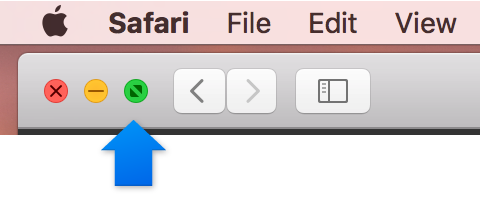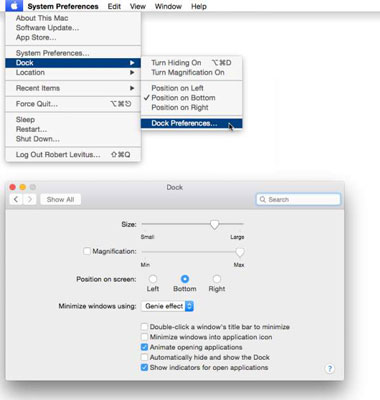App Window Be Minimized By Clicking Its Dock Icon Mac
The Dock in macOS is more flexible than you may realize. Change the size, location, color and more to fit your personal preferences.
The Dock is one of Apple’s most iconic features. It showcases the intuitive nature of their design while remaining highly customizable!
Sep 12, 2019 Working with a specific note in its own window and Evernote main window minimized to dock. When clicking on the dock icon to bring the note back to the front, Evernote main window is also restored, obscuring the note being used. It then has to be re-minimized. The Dock is a prominent feature of the graphical user interface of macOS.It is used to launch applications and to switch between running applications. The Dock is also a prominent feature of macOS's predecessor NeXTSTEP and OpenStep operating systems. The earliest known implementations of a dock are found in operating systems such as RISC OS and NeXTSTEP. I think I know what your problem is. You are minimizing your window, then trying to get back to it through the dock icon. That won't work. In macOS, clicking the dock icon will either launch a new window, or will return you to the most recently used non-minimized window. It will not un-minimize a window! I would suggest that you don't minimize a window unless you really need to for some reason. Users have two default options for the effect used when a window is minimized to the Dock: Scale and Genie. “Scale” does what its name implies and simply shrinks the application window down into the dock when minimized. “Genie” is a bit more interesting and distorts the window as it minimizes by pulling both bottom corners simultaneously. You can hide an active application by option-clicking (alt-clicking) its icon in the dock. You can also hide the active window and open another window by alt-clicking whatever application you want to open in the dock. But I agree with you that it would be more symmetrical to be able to click to minimize all the open windows in an application.
Locate the icon you downloaded on your Mac (or created) and confirm that it's in the.icns format. In the Finder, it should show up as the icon name with.icns appended to it.If the Finder is set to hide file extensions, you can see the full file name by right-clicking on the icon file and selecting Get Info from the pop-up menu. The file name with extension is displayed in the Get Info window.
Anyone can change what app shortcuts are available on the Dock. But what you may not realize is that you can also customize the Dock’s size, color, location, and more.
Contents
- 9 Extra Effects
Related Posts:
Change the Size

The dock automatically resizes depending on how many apps it holds.However, you can also resize the icons themselves, making the Dock much larger or smaller.
There are two ways to do this: with the mouse or through the System Preferences.
Using the mouse is quickest. Simply hover it over one of the vertical dividers on the Dock and drag up or down to make the Dock bigger or smaller. If that wasn’t easy enough, open the System Preferences and click the Dock button. The slider at the top of the window adjusts your Dock size.
Turn On Magnification
Magnification enlarges icons on the Dock as you hover your mouse over them. This is great for if you’ve got lots of icons, a small Dock, or a sight impairment.
Turn on Magnification by going to the Dock menu of System Preferences and ticking the Magnification checkbox. The slider to the right allows you to alter the amount of magnification to your personal taste.
Change the Location
By default, the Dock sits at the bottom of the screen. However, if you prefer you could move it to the left or right edge instead. Depending on how you use your Mac, this might make it easier to access the Dock when you need it.
Change the location of the Dock by holding shift while you click and drag one of the vertical dividers. Pull your mouse to a different edge of the screen to see the Dock relocate to that position.
Alternatively, in the Dock System Preferences, you can choose where you want the Dock to be positioned by selecting one of three options: Left, Bottom, or Right.
Hide the Dock
Free up some Desktop real estate by hiding your Dock when you don’t need it.
This handy feature allows more space for multitasking while keeping the Dock within easy reach off the screen. When you want the Dock to reappear, move your mouse to the screen’s edge and it will pop out — just like in fullscreen mode.
You can hide or show the Dock at any time by pressing cmd+alt+D. Or go to the Dock options in System Preferences and tick ‘Automatically hide and show the Dock’.
Change the Color
App Window Be Minimized By Clicking Its Dock Icon Machine
With Dark Mode on, the Dock, menu bar, Notification Centre, Finder windows, Spotlight search, and more will be dark grey or black giving a sleek new look to macOS.
Turn on Dark Mode by going into the General menu of your System Preferences. Two boxes of the top give the options of Light or Dark color schemes.
Favorite Apps
The largest part of the Dock holds shortcuts to your favorite apps. They’re easy to add, remove, or reorder by clicking and dragging the icons.
To remove an app, drag it off of the Dock or into the Trash — don’t worry, it’ll still be available to in Spotlight or Finder.
Alternately drag apps onto the Dock from the Finder window to add them to your favorites. You could also drag apps from the recent applications section of the Dock into your favorites to create permanent shortcuts.
Recent Applications
This new section of the Dock sits between favorite apps and the stack and files. It updates automatically with whatever apps are currently running or to show three recently used applications.
You can turn this feature on or off in the System Preferences. Under the Dock menu, check or uncheck the box labeled ‘Show recent applications in Dock’.
Stacks and Files
The farthest right section of the Dock is used to store stacks, files, and the Trash.
Stacks and files can be added to the Dock by dragging any files or folders from the Finder. Keeping them here makes them easily accessible and is useful if you use certain items frequently.
Stacks work just like folders: click to open and see all the files inside. By control-clicking a stack, you can customize how it opens: fan grid or list. You can also choose to view it as a traditional folder icon.
Extra Effects
Open Indicators
The little round dots that appear beneath icons on the Dock indicate whether that application is running or not. Personal money management software for mac free. You can turn this effect on or off using the Systems Preferences checkbox labeled ‘Show indicators for open applications’.
Opening Animations
The System Preferences checkbox labeled ‘Animate opening applications’ determines whether or not icons bounce up and down upon opening. Some users have suggested that turning this feature off improves performance in macOS, although for most users the difference appears to be negligible at best.
App Window Be Minimized By Clicking Its Dock Icon Mac Download
Minimize Effect
The Minimize effect allows you to move an application’s window to the Dock when you aren’t using it. This is a great organization method and can help to clear multiple windows when working.
Through the System Preferences, you can choose to store minimized windows within the app’s icon or to keep them in a row alongside your Stacks and Files. You can also choose to have a window minimize when you double-click its title bar.
Can An App Window Be Minimized By Clicking Its Dock Icon
We hope that gives you some insight into how to customize the Dock on macOS. Experiment to find your favorite settings and let us know them in the comments!
App Window Be Minimized By Clicking Its Dock Icon Mac Free
App Window Be Minimized By Clicking Its Dock Icon Mac Pro
Dan is a freelance writer based in South West England.

He spent two years supervising repairs as a Genius Admin for Apple Retail and uses that knowledge to keep our troubleshooting guides up to date.
Long before that, Dan turned to Apple products from a musical background. Having owned iPods for years, he bought a MacBook to learn sound recording and production. It was using those skills that he gained a first-class Bachelor of Science in Sound Technology.